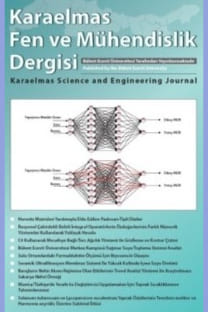Kadmiyum, Krom ve Kurşunun Ceratophyllum demersum L. ve Pogostemon erectus (Dalzell) Kuntze Üzerine Fitotoksisitesinin Değerlendirilmesi
Assessment of Phytotoxicity of Cadmium, Chromium and Lead on Ceratophyllum demersum L. and Pogostemon erectus (Dalzell) Kuntze
___
- Aravind, P., Prasad, MNV. 2003. Zinc alleviates cadmium-induced oxidative stress in Ceratophyllum demersum L.: a free floating freshwater macrophyte. Plant Physiol. Biochem., 41:391-397.
- Baykan, 2007. Kursun nitrat (Pb(NO3)2) metal tuzunun Daphnia magna (Straus 1820)(Cladocera, Crustacea) üzerindeki akut toksik etkisinin araştırılması. Yüksek Lisans Tezi, Ankara Üniversitesi, 62 s.
- Benavides, MP., Gallego, SM., Tomaro, ML. 2005. Cadmium toxicity in plants. Braz. J. Plant Physiol., 17:21-34.
- Chen, M., Zhang, L., Li, J., He, X., Cai, J. 2015. Bioaccumulation and tolerance characteristics of a submerged plant (Ceratophyllum demersum L.) exposed to toxic metal lead. Ecotoxicol. Environ. Saf., 122:313-321. Das, S., Goswami, S., Talukdar, AD. 2016. Physiological responses of water hyacinth, Eichhornia crassipes (Mart.) Solms, to cadmium and its phytoremediation potential. Turk. J. Biol., 40:84-94.
- Doğan, M. 2005. Ceratophyllum demersum L.’de kadmiyum klorür, sodyum klorür ve bunların kombinasyonlarının fizyolojik ve morfolojik etkileri. Doktora Tezi, Çukurova Üniversitesi, Adana.
- El-Khatib, AA., Hegazy, AK., Abo-El-Kassem, AM. 2014. Bioaccumulation potential and physiological responses of aquatic macrophytes to pb pollution. Int. J. Phytoremediation., 16:29-45.
- Hoagland, DR., Arnon, DI. 1950. The water-culture method for growing plants without soil, california agricultural experiment station. Circular, 347:1-32.
- Khellaf, N., Zerdaoui, M. 2009. Growth response of the duckweed Lemna minor to heavy metal pollution. Iran. J. Environ. Health. Sci. Eng., 6:161-166.
- Koca, FD. 2010. Cr(III) ve Cr(VI) maruziyetinde Ceratophyllum demersum L.’nin biyolojik cevabı: konsantrasyon ve uygulama periyodunun etkisi. Yüksek Lisans Tezi, Erciyes Üniversitesi, Kayseri.
- Lesmana, SO., Febriana, N., Soetaredjo, FE., Sunarso, J., Ismadji, S. 2009. Studies on potential applications of biomass for the separation of heavy metals from water and wastewater. Biochem. Eng. J., 44:19-41.
- Mishra, S., Tripathi, RD., Srivastava, S. 2008. Thiol metabolism play significant role during cadmium detoxification by Ceratophyllum demersum L.. Bioresour. Technol., 100:2155-2161. Murashige, T., Skoog, F. 1962. A revised medium for rapid growth and bioassays with tobacco tissue cultures. Plant Physiol., 15:473-497.
- Nagajyoti, PC., Lee, KD., Sreekanth, TVM. 2010. Heavy metals, occurrence and toxicity for plants: a review. Environ. Chem. Lett., 8:199-216.
- Nath, K., Saini, S., Sharma, YK. 2005. Chromium in tannery industry effluent and its effect on plant metabolism and growth. J. Environ. Biol., 26:197-204.
- Oros, V., Ana, T. 2012. Ecotoxicological effects of heavy metals on duckweed plants (Lemna minor). I. tests for growth rate reducing by cadmium. Sci.. Bull.. Ser. D, 26:7-14.
- Öktüren, Asri, F., Sönmez, S. 2006. Ağır metal toksisitesinin bitki metabolizması üzerine etkileri. Derim, 23:36-45.
- Piotrowska, A., Bajguz, A., Godlewska-Z˙ yłkiewicz, B., Czerpak, R., Kaminska, M. 2009. Jasmonic acid as modulator of lead toxicity in aquatic plant Wolffia arrhiza (Lemnaceae). Environ. Exp. Bot., 66:507-513.
- Radić, S., Stipaničev, D., Cvjetko, P., Mikelić, IL., Rajčić, MM., Širac, S., Pevalek-Kozlina, B., Pavlica, M. 2010. Ecotoxicological assessment of industrial effluent using duckweed (Lemna minor L.) as a test organism. Ecotoxicology, 19:216-222.
- Sánchez, D., Graça, MAS., Canhoto, J. 2007. Testing the use of the water milfoil (Myriophyllum spicatum L.) in laboratory toxicity assays. Bull. Environ. Contam. Toxicol., 78:421-426.
- Shanker, AK., Cervantes, C., Tavera, HL., Avudainayagam, S. 2005. Chromium toxicity in plants. Environ. Int., 31:739-753.
- Sharma, P., Dubey, RS. 2005. Lead toxicity in plants. Braz. J. Plant Physiol., 17:35-52.
- Sinha, S., Saxena, R., Singh, S. 2005. Chromium induced lipit peroxidation in the plants of Pistia stratiotes L: role of antioxidants and antioxidant enzymes. Chemosphere, 58: 598-604.
- Üçüncü, E. 2011. Su mercimeği (Lemna minor Linneaus 1753) kullanılarak farklı konsantrasyonlardaki ağır metal (Cu, Cr ve Pb) karışımlarının laboratuvar ortamında biyoremediasyonu. Yüksek Lisans Tezi, Ankara Üniversitesi, Ankara.
- Yıldız, M., Terzi, H., Uruşak, B. 2011. Bitkilerde krom toksisitesi ve hücresel cevaplar. E.Ü. Fen Bilimleri Enst. Derg., 27:163-176.
- Zengin, KF., Munzuroğlu, Ö. 2005. Fasulye fidelerinin (Phaseolus vulgaris L. Strike) klorofil ve karotenoid miktarı üzerine bazı ağır metallerin (Ni+2, Co+2, Cr+3, Zn+2) etkileri. F.Ü. Fen Müh. Bil. Derg., 17:164-172.
- ISSN: 2146-4987
- Yayın Aralığı: 3
- Başlangıç: 2011
- Yayıncı: ZONGULDAK BÜLENT ECEVİT ÜNİVERSİTESİ
DURMUŞ YARIMPABUÇ, MEHMET EKER, KERİMCAN ÇELEBİ
Al ve Yerleştir Robot Otomasyonu İçin Bir Çerçeve Çalışması
Kalp Hızı Değişkenliği Zaman Alanı Ölçümleri Kullanarak PAF Atağının Tahmini
ALİ NARİN, YALÇIN İŞLER, Mahmut ÖZER
Serkan SUGEÇTİ, Kemal BÜYÜKGÜZEL
HAKAN ALICI, VOLKAN KARACAOĞLAN, KADİR DEMİR
Üstbilişsel Etkinlik Envanteri: Geçerlik ve Güvenirlik Çalışması
SİNEM DİNÇOL ÖZGÜR, SENAR TEMEL, AYHAN YILMAZ
Üçüncü Mertebeden Rasyonel Bir Fark Denkleminin Global Dinamikleri
Hüseyin AYTEKİN, Alaaddin YILMAZ
Boussinesq-Stokes Süspansiyonlu Duvar Kapak Hareketli Akış Problemi için Yeni Bir Algoritma
